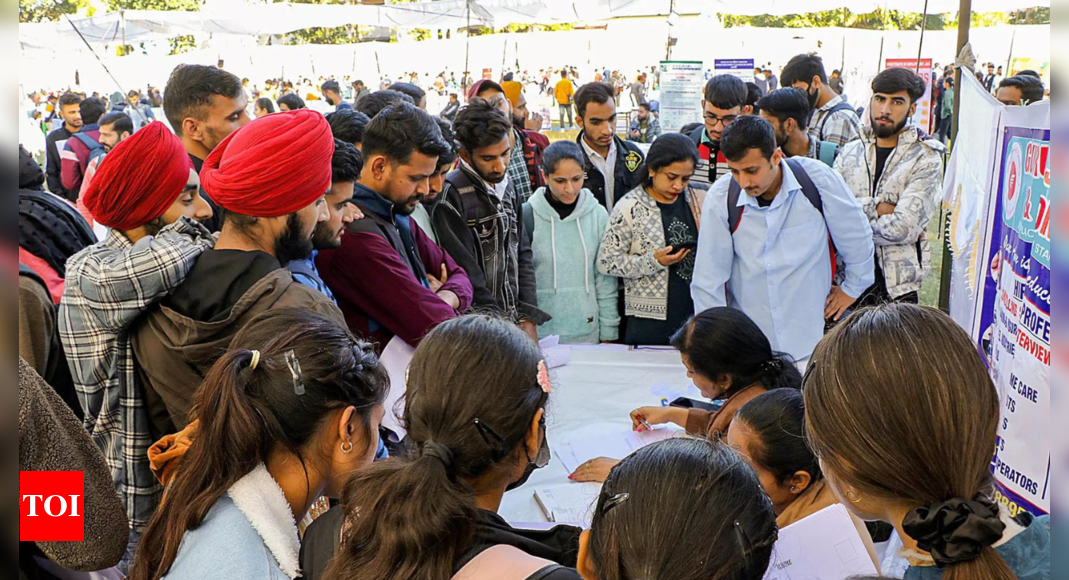[ad_1]
NEW DELHI: India’s unemployment price is anticipated to say no by as much as 97 foundation factors by 2028, in line with a brand new report launched by the Observer Analysis Basis (ORF) on Tuesday. The report, titled India Employment Outlook 2030, highlights projections indicating a decline within the unemployment price from 4.47 p.c in 2024 to three.68 p.c in 2028 as India’s economic system surges in direction of the USD 5 trillion mark.
The report highlights that India’s job market is evolving, boosted by the nation’s fast financial progress publish the Covid-19 pandemic. With a younger inhabitants, the place the median age is 28.4 years, India will witness important financial enlargementmentioned the report.
The report signifies that with a GDP progress price of seven.8%, India might probably obtain the USD 5 trillion economic system goal by 2026-27, pushed by sturdy non-public consumption and public funding.
At present standing at slightly below USD 4 trillion in 2024, India’s GDP measurement is anticipated to develop additional. The report additionally recognized sectors deemed aspirational by its 600-million-plus inhabitants aged 18-35 years. These sectors are anticipated to behave as engines of progress, probably resulting in a 22 p.c enhance in total employment by 2028.
The service sector, particularly, is anticipated to witness substantial job creation, with every unit rise in providers output anticipated to contribute to a 0.12% enhance in employment. Ten high-opportunity sub-sectors inside the providers house together with digital providers, monetary providers, well being providers, hospitality, client retail, e-commerce, and renewable power.
Moreover, the report underlined the necessity to concentrate on ladies’s employment inside the service sector, stressing the significance of investing in ladies’s skilling, monetary inclusion, and entrepreneurship. Nonetheless, the outlook for India’s manufacturing sector is much less optimistic, regardless of initiatives like Make in India and the nation’s aggressive value constructions.
Technological developments and automation pose challenges for employment within the manufacturing sector, resulting in a decline in workforce absorption. To handle this, the report suggests transitioning in direction of industrial worth chains related to the service sector for employment rejuvenation.
Nilanjan Ghosh, a director at ORF and one of many report authors, emphasised the significance of policymakers collaborating with stakeholders to bridge employability gaps and improve abilities. He mentioned, “Policymakers and public sector schemes might accomplice extra carefully with different stakeholders to determine employability and skilling gaps. The subsequent step could be to improve curricula and abilities to make India’s expertise pool extra trade prepared.”
Ghosh added that nurturing entrepreneurship could be essential for improved next-gen employment. “A brand new class of entrepreneurs might stimulate job creation, increase India’s startup ecosystem, spur innovation, and promote youth participation. However we additionally want to make sure that the workplaces of the long run are gender-sensitive and inclusive,” he added.
The report advocates for a collaborative strategy amongst stakeholders to attain India’s imaginative and prescient of a digitally empowered, expert, modern, and self-reliant economic system.
The report highlights that India’s job market is evolving, boosted by the nation’s fast financial progress publish the Covid-19 pandemic. With a younger inhabitants, the place the median age is 28.4 years, India will witness important financial enlargementmentioned the report.
The report signifies that with a GDP progress price of seven.8%, India might probably obtain the USD 5 trillion economic system goal by 2026-27, pushed by sturdy non-public consumption and public funding.
At present standing at slightly below USD 4 trillion in 2024, India’s GDP measurement is anticipated to develop additional. The report additionally recognized sectors deemed aspirational by its 600-million-plus inhabitants aged 18-35 years. These sectors are anticipated to behave as engines of progress, probably resulting in a 22 p.c enhance in total employment by 2028.
The service sector, particularly, is anticipated to witness substantial job creation, with every unit rise in providers output anticipated to contribute to a 0.12% enhance in employment. Ten high-opportunity sub-sectors inside the providers house together with digital providers, monetary providers, well being providers, hospitality, client retail, e-commerce, and renewable power.
Moreover, the report underlined the necessity to concentrate on ladies’s employment inside the service sector, stressing the significance of investing in ladies’s skilling, monetary inclusion, and entrepreneurship. Nonetheless, the outlook for India’s manufacturing sector is much less optimistic, regardless of initiatives like Make in India and the nation’s aggressive value constructions.
Technological developments and automation pose challenges for employment within the manufacturing sector, resulting in a decline in workforce absorption. To handle this, the report suggests transitioning in direction of industrial worth chains related to the service sector for employment rejuvenation.
Nilanjan Ghosh, a director at ORF and one of many report authors, emphasised the significance of policymakers collaborating with stakeholders to bridge employability gaps and improve abilities. He mentioned, “Policymakers and public sector schemes might accomplice extra carefully with different stakeholders to determine employability and skilling gaps. The subsequent step could be to improve curricula and abilities to make India’s expertise pool extra trade prepared.”
Ghosh added that nurturing entrepreneurship could be essential for improved next-gen employment. “A brand new class of entrepreneurs might stimulate job creation, increase India’s startup ecosystem, spur innovation, and promote youth participation. However we additionally want to make sure that the workplaces of the long run are gender-sensitive and inclusive,” he added.
The report advocates for a collaborative strategy amongst stakeholders to attain India’s imaginative and prescient of a digitally empowered, expert, modern, and self-reliant economic system.
[ad_2]
2024-04-16 13:10:27
[





















+ There are no comments
Add yours